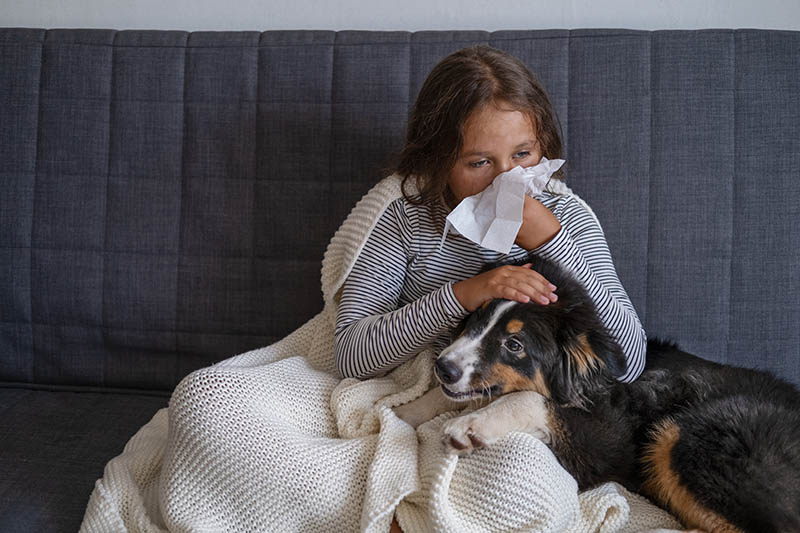Animal hair is all the same, right? Nope!
So, yes, you can be allergic to dogs and not cats.
Your immune system is a coordinated network of organs, tissues, cells, and proteins that protect you from germs and disease. Antibodies are proteins produced by your immune system in response to unwanted invaders. Unfortunately, your body may produce antibodies in response to specific proteins found in your pet’s dander, saliva, and urine, mistaking it as something harmful. This is how pet allergies form and why you may be allergic to dogs but not cats.
What Makes Up the Immune System?
The immune system is an intricate collaboration of cells and tissues working together to protect you from illnesses.
- Antibodies
- White blood cells
- Thymus gland
- Spleen
- Tonsils
- Bone marrow
- Lymph nodes and vessels

What Causes an Allergy?
Your immune system records every germ it has encountered, attacked, and defeated. This memory allows your immune system to quickly recognize and destroy the germ if it enters your body again. Allergies develop when antibodies are formed in response to a foreign substance such as pollen, mold, or certain foods your body has recognized as harmful, even though it is not.
Any substance your body doesn’t recognize as its own is known as an antigen. A common example is the protein found in dead skin cells, or dander, from dogs and cats. Antigens trigger an immune response, which results in the production of antibodies to target and destroy the unfamiliar substance. The key is in the specific protein that your body has misidentified as a harmful invader, which is why you may be allergic to one pet but not another. The protein in dog dander differs from the protein in cat dander.

What Are the Signs of Being Allergic to My Dog?
Signs of a dog allergy include inflammation of your nasal passages, lungs, or skin that may present as:
- Sneezing
- Coughing
- Runny nose
- Itchy, watery eyes
- Nasal congestion
- Wheezing
- Shortness of breath
- Hives
- Itchy skin
Can You Live With a Dog if You Are Allergic?
Yes! You can live with a dog even if you are allergic to them. The key is managing your symptoms. Thankfully, there are medications you can take to lessen allergy signs while caring for your best friend. Medications may include antihistamines, corticosteroids, and decongestants. Nasal irrigation and allergy shots may also help reduce your sensitivity to the allergen.

Are Hypoallergenic Dogs Helpful for Allergy Sufferers?
Hypoallergenic means reducing the possibility of causing an allergic reaction. Unfortunately, no dog is 100% hypoallergenic as all dogs shed dander and produce saliva and urine. It’s not the fur that is the issue; it’s the dander and saliva proteins trapped in it.
However, some breeds, such as the Poodle, Shih Tzu, and Bichon Frise, shed their fur less often than other dog breeds. This may be helpful for allergy sufferers as the dander is mostly contained to the dog instead of scattered in loose fur all over the home.
Even so, individuals can have an allergy to low-shedding breeds as the proteins that trigger an inflammatory response are still there.

Tips for Keeping Your Dog Allergy at Bay
Other ways to reduce allergies include:
- Bathing your dog once a week
- Brushing your dog regularly
- Wiping your dog with a damp cloth to remove outside allergens (e.g., pollen or mold)
- Changing air filters in your home often
- Vacuuming and mopping frequently
- Confining your dog to a part of your home that is easy to clean
- Washing your hands with soap and water after interacting with your dog

Conclusion
Proteins found in pet dander, saliva, and urine can trigger an allergy. An allergy forms when your immune system mislabels a substance as harmful and produces antibodies against it. You can be allergic to dogs but not cats because the unique protein structure differs between the two species.
Allergens can even be different among dogs of the same breed, meaning that you can be allergic to one dog but not the other. If you are allergic to dogs, you can still enjoy living with them if your symptoms are manageable and you limit your exposure to the allergens.
Featured Image Credit: New Africa, Shutterstock











